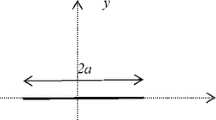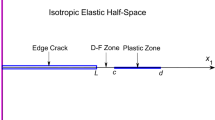Abstract
In this paper we consider a moving Griffith-type strip crack subjected to three fundamental modes of surface tractions in an infinite, homogeneous, isotropic, elastic solid. Closed form solutions are obtained in detail for the mode II case for the components of the resulting stress fields using a method of dislocation layers and some numerical results are given. Some implications of the results for brittle and ductile crack growth are discussed.
Résumé
On considère une fissure plane du type Griffith en cours de propagation dans un solide infini, homogène, isotrope et élastique, sous l'action des trois modes fondamentaux de sollicitations de ses surfaces.
En utilisant une méthode recourant à des couches de dislocations, on a obtenu des solutions de forme fermée décrivant dans le détail, pour le mode II, les composantes des champs de contraintes qui sont associés à ce mode. Des résultats numériques sont communiqués et diverses implications qu'entraînent les conclusions de ce travail sont discutées dans le cas de la propagation fragile ou ductile d'une fissure.
Zusammenfassung
In diesem Bericht wird ein sich ausdehnender Riss “Typ Griffith”, der den drei fundamentalen Arten von Oberflächenzugspannung unterliegt in einem unendlichen, homogenen, isotropen, elastischen festen Körper.
Man erhält eingehende geschlossene Lösungen für die Art II für die Komponenten des Spannungsfeldes durch den Gebrauch eines Dislokationsschichten Verfahrens und man gibt einige Ergebnisse. Einige Folgen der Ergebnisse für spröde oder zähe Rissausdehnung werden besprochen.
Similar content being viewed by others
References
C. Zener,Fracturing of Metals, Cleveland Symposium, A.S.M. (1948).
B. A. Bilby, A. H. Cottrell and K. Swinden,Proc. Roy. Soc., A272 (1963) 304.
B. A. Bilby and J. D. Eshelby,Fracture (ed. H. Liebowitz), Academic Press, New York, Vol. 1 (1968) 99.
R. W. Lardner,Quart. J. Mech. Appl. Math., 25 (1972) 45.
J. Guidera,Planar distributions of dislocations, M.Sc. thesis, Simon Fraser University (1972).
E. H. Yoffe,Phil. Mag., 42 (1951) 739.
G. C. Sih,Int. J. Fracture Mechs., 4 (1968) 51.
W. P. Chen,A Re-examination of Some Crack Problems in the Linear Theory of Elasticity, SFU Preprint, (1971).
J. D. Eshelby,Proc. Phys. Soc. London, A62 (1949) 307.
N. I. Muskhelishvili,Singular Integral Equations, Noordhoff (1953).
F. D. Gakhov,Boundary Value Problems, Pergamon, Oxford (1966).
A. H. Cottrell,Proc. Roy. Soc., A285 (1965) 10.
J. F. Knott and A. H. Cottrell,J. Iron and Steel Inst., 201 (1963) 249.
Author information
Authors and Affiliations
Rights and permissions
About this article
Cite this article
Lardner, R.W., Tupholme, G.E. Dislocation layers applied to moving crack problems. Int J Fract 10, 113–119 (1974). https://doi.org/10.1007/BF00955086
Received:
Revised:
Issue Date:
DOI: https://doi.org/10.1007/BF00955086




